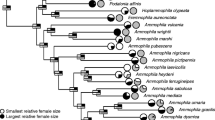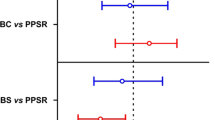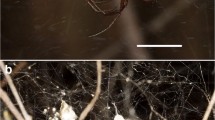Summary
The sphecid wasp Sceliphron assimile Dahlbom builds mud cells whose volumes are positively correlated to maternal length, the relationship being highly significant for daughters (Fig. 1). However, small females build cells longer and wider in relation to their own body length than large females do (Fig. 3). Cell volume closely regulates the total weight of prey stocked per cell (Figs. 4, 10). Maternal length is directly related to prey size and inversely related to the number of prey stocked (Fig. 5). Female length, above a threshold of 19 mm, probably does not influence her chance of starting a nest (Fig. 6) but is strongly positively correlated to achieved fecundity. Large females have larger offspring and a higher proportion of daughters than small females do (Fig. 7), but this is largely controlled by maternal behaviour rather than by genetical mechanisms (Fig. 10). The results are in general agreement with those of Trivers and Hare (1976) for solitary wasps, but large progeny are cheaper to produce per unit weight than small ones, and for a given weight sons are cheaper to produce than daughters.
Similar content being viewed by others
References
Alexander RD, Sherman PW (1977) Local mate competition and parental investment in social insects. Science 196:494–500
Bailey NTJ (1959) Statistical methods in biology. English Universities Press, London
Crozier RH (1970) Coefficients of relationship and the identity of genes by descent in the Hymenoptera. Am Nat 104:216–217
Evans HE (1977) Extrinsic versus intrinsic factors in the evolution of insect sociality. BioScience 27:613–617
Fisher RA (1930) The genetical theory of natural selection. Clarendon Press, Oxford
Freeman BE (1973) Preliminary studies on the population dynamics of Sceliphron assimile (Dahlbom) (Hymenoptera: Sphecidae) in Jamaica. J Anim Ecol 42:173–182
Freeman BE (1974) The distribution in Jamaica of the mud wasp Sceliphron assimile (Dahlbom) (Sphecidae) and its associates. Caribb J Sci 14:115–124
Freeman BE (1977) Aspects of the regulation of size of the Jamaican population of Sceliphron assimile (Dahlbom) (Hymenoptera: Sphecidae). J Anim Ecol 46:231–248
Freeman BE (1980) A population study in Jamaica on adult Sceliphron assimile (Dahlbom) (Hymenoptera: Sphecidae). Ecol Entomol 5:19–30
Freeman BE (1981a) Parental investment in a solitary wasp. Am Nat 117:357–362
Freeman BE (1981b) The dynamics in Trinidad of Trypoxylon palliditarse Saussure: a Thompsonian population? J Anim Ecol 50:563–572
Freeman BE (1981c) The comparative population dynamics in Trinidad of two Sceliphron spp. (Hymenoptera: Sphecidae). Biol J Linn Soc 16 (in press)
Freeman BE, Johnston BY (1978a) The biology in Jamaica of the adults of the sphecid wasp Sceliphron assimile (Dahlbom). Ecol Entomol 3:39–52
Freeman BE, Johnston BY (1978b) Gregarious roosting in the sphecid wasp Sceliphron assimile (Dahlbom). Ann Entomol Soc Am 71:435–441
Freeman BE, Parnell JR (1973) Mortality of the wasp Sceliphron assimile (Dahlbom) (Sphecidae) caused by the eulophid Melittobia chalybii Ashmead. J Anim Ecol 42:779–784
Hamilton WD (1964) The genetical evolution of social behaviour. I, II. J Theor Biol 7:1–52
Hamilton WD (1967) Extraordinary sex-ratios. Science 156:477–488
Harperding HC (1979) The population genetics of interactions. Am Nat 113:622–630
Jayakar SD (1963) Proterandry in solitary wasps. Nature 198:208–209
Jayasingh DB (1977) The biology and population dynamics in Jamaica of some solitary Aculeata, with special reference to Pachodynerus nasidens (Latr.) (Eumenidae). PhD thesis, University of the West Indies
Maynard Smith J (1980) A new theory of sexual investment. Behav Ecol Sociobiol 7:247–251
Southwood TRE (1978) Ecological methods, 2nd ed. Methuen, London
Trivers RL, Hare H (1976) Haplodiploidy and the evolution of the social insects. Science 191:249–263
West Eberhard MJ (1975) The evolution of social behaviour by kin selection. Q Rev Biol 50:1–23
Author information
Authors and Affiliations
Rights and permissions
About this article
Cite this article
Freeman, B.E. Parental investment and its ecological consequences in the solitary wasp Sceliphron assimile (Dahlbom) (Sphecidae). Behav Ecol Sociobiol 9, 261–268 (1981). https://doi.org/10.1007/BF00299881
Received:
Accepted:
Issue Date:
DOI: https://doi.org/10.1007/BF00299881




